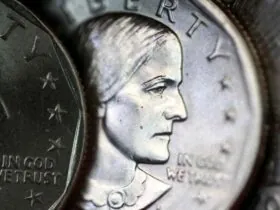If you’re curious about the 1961 quarter’s value and significance, you’ve come to the right place. Known as the Washington Quarter, this coin holds a special place in numismatic history, as it features George Washington, the first President of the United States. With its silver composition and historical charm, it remains a favorite among collectors. Let’s dive into the details of this fascinating coin.
Historical Significance of the 1961 Washington Quarter
This Article Includes [hide]
The 1961 Washington Quarter represents one of the final years of silver coinage in the United States. From 1932 to 1964, quarters were composed of 90% silver and 10% copper. After 1964, the U.S. Mint transitioned to a copper-nickel composition. The 1961 quarter’s silver content not only contributes to its intrinsic value but also makes it a relic of a bygone era in American coinage.
Design Details
Obverse
The obverse of the 1961 quarter features a left-facing bust of George Washington. Above the bust is the inscription “LIBERTY,” while the motto “IN GOD WE TRUST” appears below his chin. The year “1961” is displayed prominently along the bottom edge. The design’s simplicity contrasts with the more intricate reverse.
Reverse
The reverse design showcases an American Bald Eagle with outstretched wings, clutching arrows in its talons. A laurel wreath curves beneath the eagle, symbolizing peace and victory. Above the eagle’s head is the Latin motto “E PLURIBUS UNUM” (“Out of Many, One”). The words “UNITED STATES OF AMERICA” arc along the top rim, while “QUARTER DOLLAR” is positioned at the bottom.
Specifications
- Metal Composition: 90% silver, 10% copper
- Diameter: 24.3 mm
- Thickness: 1.75 mm
- Weight: 6.26 grams
- Edge: Reeded
- Silver Content: Approximately 0.1808 troy ounces
Mintage and Variants
Philadelphia Mint (No Mint Mark)
The Philadelphia Mint produced 37,036,000 quarters in 1961. Coins from this mint do not bear a mint mark. The Philadelphia Mint only began using the “P” mint mark in 1979, making earlier coins easily identifiable by the absence of a mark.
Denver Mint (D Mint Mark)
The Denver Mint had a significantly higher mintage of 83,656,928 quarters in 1961. These coins are marked with a “D” mint mark, found on the reverse, just beneath the laurel wreath and above the denomination.
Value of the 1961 Washington Quarter
The value of a 1961 quarter depends on its condition, rarity, and any unique characteristics such as errors.
Philadelphia Mint (No Mint Mark)

- Average Condition (Fine): $6.75
- MS 60 (Uncirculated): $10
- MS 63: $17.50
- MS 65: $30
- MS 67: $240 to $4,950
A 1961 quarter in MS 67+ fetched a record price of $9,777 at a Heritage Auction in 2009.
Denver Mint (D Mint Mark)

- Average Condition (Fine): $5.50 to $6.75
- MS 60 (Uncirculated): $10
- MS 63: $17.50
- MS 66: $150
- MS 67: $1,000 to $7,400
The highest auction price for a 1961 D quarter was $24,000 at Stack’s Bowers in 2019.
Proof Coins

The Philadelphia Mint also produced 3,028,244 proof quarters in 1961. These coins are highly detailed and often designated as “PR” or “PF.”
- PR 65: $25
- PR 67: $35
- PR 68: $40
- PR 70: $200 to $500
Notable Errors and Variants
Double Die Obverse (DDO)

This error occurs when the die shifts during the minting process, resulting in a doubled design. Examples graded as PR 67 have sold for up to $400, while higher-quality specimens with DCAM designation have fetched $580.
Struck on a Nickel Planchet
This rare error involves the quarter being struck on a planchet meant for a nickel, weighing approximately 5 grams. Such errors primarily appear on Denver-minted coins and can sell for $280 in AU 50 condition.
Struck on a Penny Planchet

When a quarter is mistakenly struck on a penny planchet, it results in a smaller, copper-toned coin. One example graded MS 63 RB sold for $1,800.
Re-punched Mint Mark (RPM)

This error, specific to Denver coins, occurs when the mint mark is struck twice at different angles. An MS 65 example with this error can be worth $500.
Grading the 1961 Washington Quarter
Coins are graded on the Sheldon scale, which ranges from 1 (poor) to 70 (perfect). Proof coins are graded similarly but are prefixed with “PR” or “PF.” High-grade coins with minimal wear or exceptional strikes command premium prices. For accurate grading, consult professional services like the PCGS or NGC.
Where to Buy or Sell 1961 Quarters?
There are several platforms where you can buy or sell 1961 quarters:
- Auction Houses: Heritage Auctions, Stack’s Bowers
- Online Marketplaces: eBay, Etsy
- Coin Dealers and Shops: Certified coin dealers can provide accurate valuations.
- Coin Shows: A great place to connect with collectors and experts.
FAQs
What is the value of a 1961 quarter?
In average condition, a 1961 quarter is worth around $6 to $7. However, rare high-grade examples or those with errors can fetch thousands of dollars.
Are 1961 quarters made of silver?
Yes, 1961 quarters are composed of 90% silver and 10% copper.
What are proof coins?
Proof coins are specially struck with high-quality dies and are often collected for their sharp details and reflective surfaces.
The 1961 Washington Quarter is a timeless piece of American history, valued for its design, composition, and rarity. Whether you’re a seasoned numismatist or a new collector, understanding this coin’s nuances can add value to your collection.
Read More:
THIS IS ONLY A BLOG POST FOR INFORMATION – WE DO NOT BUY, SELL, OR APPRAISE THESE ITEMS











Leave a Reply